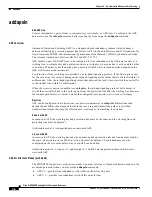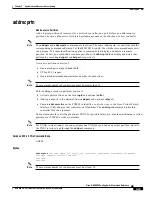
3-15
Cisco MGX 8850 Routing Switch Command Reference
Release 2.0, Part Number 78-10467-04 Rev C0, October 2001
Chapter 3
Equipment and Resource Provisioning
addport
addport
Add Port—add a logical port (to the VSI slave).
A logical port is associated with a physical line. For a UNI or NNI, a line can support one logical port.
For a virtual NNI (VNNI), a line can support multiple logical ports.
The range of logical port numbers is 1–60 for the AXSM regardless of the interface type (UNI, NNI, or
VNNI). For example, if a card supports 4 lines and all lines support UNI, the card can have 4 logical
ports whether their numbers are 1–4, 11–14, 57–60, and so on.
You can only execute addport, on a currently active line. See upln.
Note
The maximum number of logical ports for the entire node is 99. This value is imposed by the
PXM45/A.
Note
If your are going to use card statistics, you must execute cnfcdstat before you add any logical ports
using addport. You cannot configure card statistics once you have any logical ports added.
The information you specify with addport consists of the:
•
Logical port number
•
Line number and bay number
•
Guaranteed rate and the maximum rate—currently the same for all interface types
•
Service class template ID for the logical interface
•
Type of interface (UNI, NNI, or VNNI)
•
VPI for all connections on the port if the interface type is VNNI
The node supports a template approach to specifying parameters for large numbers of connections. (You
can modify an individual connection as needed using cnfcon.) The name of such a template is Service
Class Template (SCT). The targets of template application are the logical ports on the one hand and the
card itself on the other. The addport command lets you specify an SCT for a port, and cnfcdsct lets you
specify an SCT for the card. You can specify the same or different SCT number for either the port or
card-level, but you definitely need to specify an SCT for each card and port. The system automatically
assigns a card-level SCT to a card or a port-level SCT of the same number to a port. (For example, if
you specify SCT 2 for a port, the system does not assign card-level SCT 2 to that port.)
Cisco Systems provides SCT numbers 2 and 3. SCT 2 contains policing parameters, but SCT 3 does not.
You should specify SCT 2 or 3 or create new templates by modifying SCT 2 or 3 in the Cisco WAN
Manager application and saving them with different SCT numbers. To see the actual values in an SCT,
use dspportsct for a port SCT or dspcdsct for a card-level SCT. To see a list of SCT files on the disk,
execute cd to get to the SCT directory, then execute ls to find the directory named “AXSM.”
Until you specify an SCT, the AXSM has a default SCT of 0. The system uses SCT ID = 0 when:
•
The AXSM is powered-up for the first time.
•
The card’s database is rebuilt.
•
The card is rebooted and the user-specified SCT file for a particular port is corrupt or missing. In
this situation, the default applies to only the affected port.
















































